Home Free_Banjo_Information Learn_Fiddle_CD Learn_Banjo_CD Ordering_Information Contact_Information Submit_Questions
How to choose a fiddle How to choose a banjo Looking to Purchase an Instrument? |

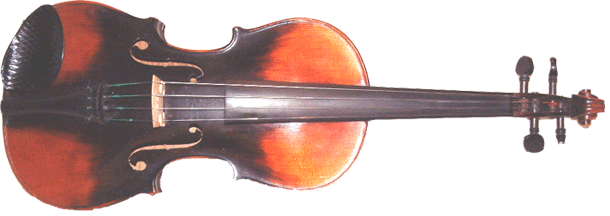
BLUEGRASS FIDDLE
Now that you've decided to start playing fiddle, there are so many new things for you to learn! You probably have lots of questions, and this website is here to help answer those questions. The Beginning Bluegrass Fiddle CD is designed to go along with this website, and contains all of the other information you need to learn to play. But regardless of whether you purchase the CD, we hope that this site will provide you with some good information to help you get started and answer your questions. If you don't see the answer to your question, please feel free to contact us and we'll make every effort to reply quickly.
WHAT'S THE DIFFERENCE BETWEEN A FIDDLE AND A VIOLIN?
There is no difference between a fiddle and a violin. It is like saying pancake or flapjack. Most people refer to violin when they are describing
classical music, and fiddle when they are referring to bluegrass, country, old-time style, etc. There may be a slight difference in set-up, depending upon what sound you
would like to get. For instance, in classical music, players might prefer gut, composite or perlon strings. Fiddle players are more likely to use steel or aluminum strings.
TUNING
Purchasing a tuner will help greatly in this process, but it's even more helpful if someone else will help you get it close before you use your tuner. Another option
that will make it easier to tune your fiddle is to have fine tuners installed on the tailpiece of your fiddle. Once in tune, the fiddle shouldn't change much, so then you will
probably not need any assistance other than your tuner. The only exception to this will be when you have new pegs or strings on your fiddle, or if your fiddle is subjected to
changing temperatures. (In particular, the dry cold weather in winter will sometimes cause the pegs to slip and come completely out of tune.) If you are having trouble keeping
the pegs from slipping excessively, I suggest purchasing liquid peg drops from your local music store. A bottle of this stuff will last FOREVER and is invaluable in the
winter!
Listed below is how the fiddle strings should be tuned:
1st string - E (farthest to the right when the fiddle is in playing position)
2nd string - A
3rd string - D
4th string - G
As you are tuning the fiddle, the top of the bridge will start to lean forward, especially if the fiddle had very loose strings when you started. Make sure you watch for this, as eventually the bridge will fall if you do not move it. (The bridge is not glued on the fiddle. It just sits on top of the fiddle and the strings hold it in place.) As you tune, if you notice the bridge leaning forward, simply hold the top of the bridge with your fingers and pull the top of it back slightly towards the tailpiece of the fiddle. The correct position when you are finished tuning is for the bridge to lean slightly back towards the tailpiece rather than straight up and down or forward. If the bridge does fall, you will need to loosen the strings and put it back up again and retune. The correct placement of the bridge is between the marks on the f holes. Usually the "E" string side of the bridge is a little bit lower than the "G" string side, so you will want to make sure that you don't put the bridge on backwards. Also, if there is a logo or name on the bridge, that side of the bridge usually faces the tailpiece.
HOW DO I KNOW WHERE TO PUT MY FINGERS? THERE AREN'T ANY FRETS!
The best thing to do in the beginning is to have a local violin shop put tapes on your fiddle
where your fingers should go. Typically, there will be three tapes in the beginning. If you have a tuner, you can
put these on yourself. The best type of tape to buy is colored electrical tape. You will need to cut three narrow strips
that are long enough to go all the way around the neck of the fiddle. Make sure your fiddle is in tune and that you have
a pencil handy. Play the "E" string, then fret it and watch your tuner. You want the first tape to be at "F#". Mark that
spot with your pencil. It will be approximately an inch from the nut, depending upon the size and scale of your fiddle. The
next marking will be at "G#". (You are still working on the "E" string.) The third mark will be close to the second mark and
it will be "A". Once you have all the marks made, take your electrical tape strips and put them at each mark. The easiest
way to get them under the strings is to start at the bridge and then move them up towards the neck until they are in the
right place. In the beginning, your first finger will always play at the first tape, second finger at the second tape, and
ring finger at the third tape. The tapes will be in the right place for all four strings. Click
here for a picture of the tapes in the correct position on the fiddle.
If you would like to order Don't Fret Finger Position Decals, you can do so by clicking on the Ordering_Information link. Don't Fret Finger Position Decals apply quickly and easily to your fiddle fingerboard. They are mathematically designed and precision-printed to help beginning students learn where to put their fingers. They are extremely durable, and remove cleanly from the fingerboard without leaving adhesive stickiness. They come individually packaged with instructions included. And if you are wondering, no, we have nothing to do with this company, but we think their product is great!
PROPER BOW POSITION (RIGHT HAND)
Holding the Bow
Place the thumb of your right hand either in the crook of the bow between the frog and the stick, or on the bottom of the frog. Your middle finger will be positioned directly across
from your thumb, and your first finger will rest on the stick at the 2nd (middle) knuckle. In addition, the first finger knuckle will point towards the end of the bow.
Note: Be careful not to allow your first finger to rest on the first knuckle, as this will cause your bow hand to face the wrong direction on the bow.
The ring finger and pinky will be placed comfortably on the stick behind the middle finger, right as they fall into place naturally.
Position and Movement of the Wrist
The position of the wrist will change according to how close your wrist is to the fiddle. When close to the fiddle, your wrist should be bent forward,
and as you bow away from the fiddle, your wrist should straighten out and eventually bend slightly backwards (if you bow all the way to the end of the bow).
Without this movement, the bow will slide crossways across all the strings on the fiddle.
Correct Bowing (watch wrist movement)
Incorrect Bowing (no wrist movement)
Note: A flexible wrist is of utmost importance to fiddle playing!
When bowing, keep the bow about halfway between the bridge and the fingerboard. You may bow closer to the fingerboard, but do not bow closer
to the bridge, as the sound becomes very harsh when bowing too close to the bridge.
Position and Movement of the Right Arm
Depending upon what string you want to play, you will have to move your right arm/elbow up or down. Moving the arm/elbow upwards will help you
bow the lower strings (especially the G string). Moving your arm/elbow downwards will help you bow the higher strings.
Position of the Bow
Try to bow using the middle third of the bow. It is helpful to put two pieces of tape on the bow, separating it into three sections. This allows you to easily
see the middle section where it is ideal to try to keep the bow. You will need to bow outside of this area, but the idea is to keep you from bowing continually at one
end of the bow entirely.
Producing a Good Sound
If you are not producing any sound at all when you pull the bow across the strings, or if the bow is slipping a lot, that means that you will need to put rosin
on the bow hair. If you are hearing screeches and other "deathly" sounds, it is usually attributed to pressing too hard on the bow when pulling it across the strings,
or else pulling the bow too slowly across the strings. Squeaks may also occur if you bow too close to the bridge, or if one of your left hand fingers accidentally
brushes against a string that you are bowing.
How to Rosin the Bow
You need to have rosin to put on the bow hair. As stated in the above paragraph, no sound will be produced when
the bow is pulled across the fiddle strings if there is no rosin on the bow (only brand new bows have no rosin on them at
all). Rosin also helps keep the bow from slipping
across the strings when playing fiddle. You will need to rosin the bow if you notice it is slipping. There are two ways
you can rosin the bow, both of which you may view by clicking on the links below.
Link 1 - Hold the rosin in your left hand and move the bow across the rosin as if you are playing the rosin instead of the
strings on the fiddle. You will have to go back and forth across the entire bow several times.
Link 2 - Hold the bow in your left hand with the hair pointing upwards. Move the rosin back and forth across the bow hair
in short strokes until you have covered all the hair. Then pull the rosin all the way across the bow hair several times to
make sure that the rosin in deposited evenly on the bow.
Note: Never touch the bow hair! It will leave oil on the hair and then the rosin will not stick to the bow, and the bow
slip across the strings.
PROPER FINGERING POSITION (LEFT HAND)
Position of the Hand
The fiddle neck should rest between the first knuckle of the thumb and third knuckle of the index finger (where your index finger attaches to your palm).
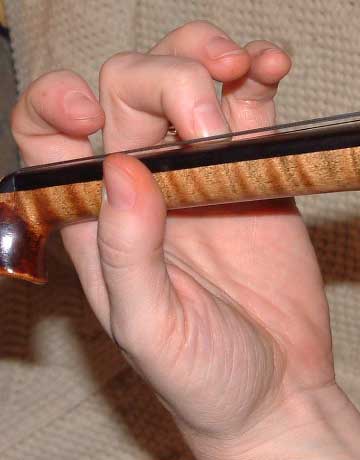
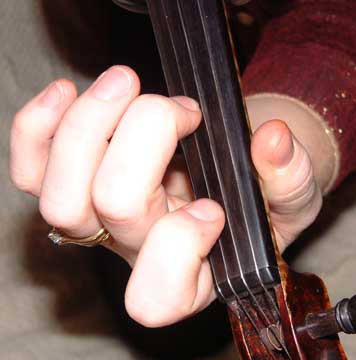
Note: Do not grip the fiddle. You may want to buy a shoulder rest to help you hold the fiddle if you find yourself gripping or feeling like you are going to
drop the fiddle. I recommend the "Kun" Brand or "Viva" Brand shoulder rests. You can order them by clicking on the
Ordering_Information link.
Position of the Left-Hand Wrist
The wrist should be straight. If your wrist is bent, you will not be able to reach some fingering positions without moving your wrist first. This also
keeps your fingers in an ideal position to note on all strings.
POSITION OF THE FIDDLE
Your fiddle should have a chin rest. If you are not comfortable with the one that is on your fiddle, or if your fiddle doesn't have one,
you should purchase one that you are comfortable with. They are inexpensive and there are many different sizes and shapes available.
With your body facing forward and your head turned slightly to the left, the fiddle should be positioned with your chin in the chinrest and over your left shoulder.
Your left arm will be positioned under the fiddle neck and to the left of your body. (Not out in front.) This positioning is needed for proper right hand bowing techniques. If
the fiddle is positioned directly in front of you, you will not have the room you need to produce full bowing motion with your right arm. You may want to look in a mirror
to help you.
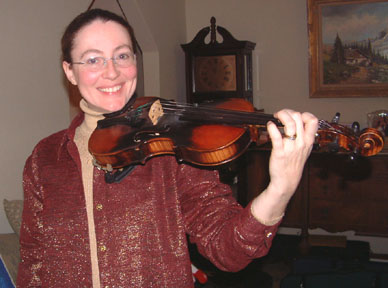
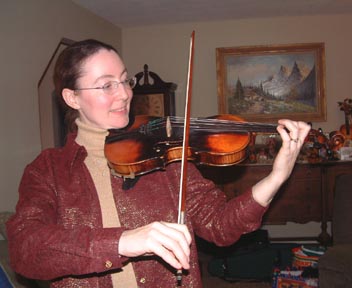
Using a Shoulder Rest
A shoulder rest is an ideal way to start playing. Not only does it help to hold the fiddle (which frees your left hand from the double duty of fingering and
holding at the same time), but it also helps to correctly position the fiddle.
TIGHTENING AND LOOSENING THE BOW
The tension of the bow hair is adjusted by turning the knob at the end of the bow. Turning clockwise will tighten
the bow hair, and turning counter-clockwise will loosen the bow hair. It is important not to overtighten the bow hair. This
may cause the bow to bounce when you try to play, or worse yet -- it may cause the bow to warp or lose its natural curve.
After every practice session before putting the bow away, you should be sure to loosen the bow hair.
NEED TO KNOW HOW TO CHOOSE / PURCHASE A FIDDLE?
Due to the many requests I have received, I have added a new link to this website with information
on purchasing a fiddle. It answers questions about buying new, used and vintage fiddles, and even gives some suggestions
as to where to purchase a fiddle. Take a look here for all the details.
PRIVATE LESSONS
If you live in the metropolitan St. Louis area, you might want to take private fiddle lessons. If so, contact
Chris Talley Armstrong.
Copyright 2003-2015 by Chris Talley Armstrong
URL: http://www.learnbluegrass.com/fiddle.html
Last updated: October 6, 2015
Contact information: learnbluegrass@aol.com